Title
Daphne
1897
Artist
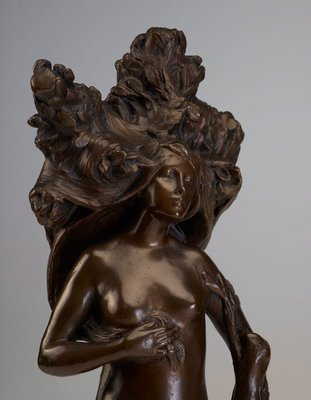
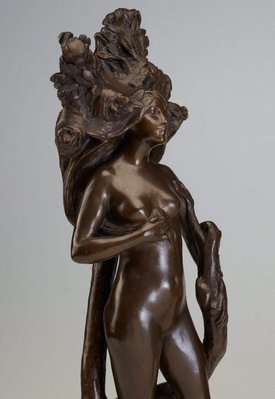
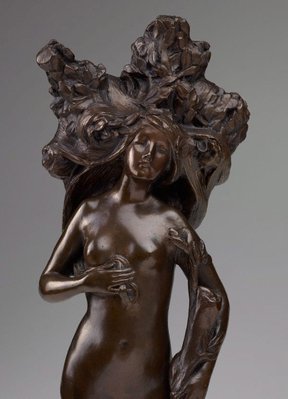
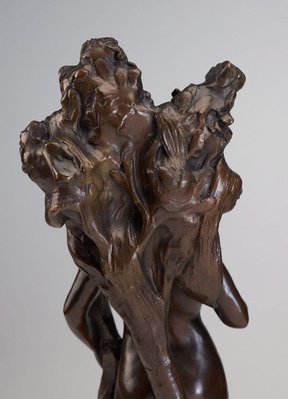
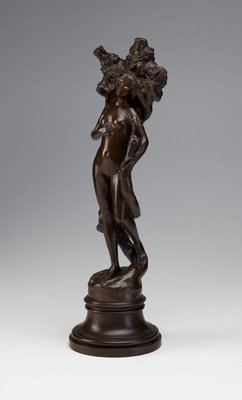
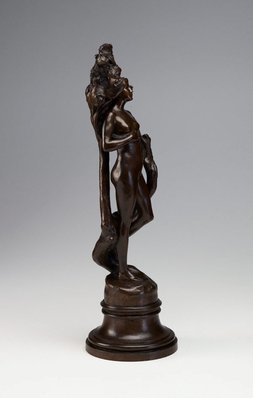
-
Details
- Date
- 1897
- Media category
- Sculpture
- Materials used
- bronze
- Edition
- 1/3
- Dimensions
- 50.5 x 15.5 x 15.5 cm
- Signature & date
Signed l.l. top of base, incised "B. MACKENNAL". Not dated.
- Credit
- Barbara Tribe Bequest Fund 2014
- Location
- South Building, ground level, Grand Courts
- Accession number
- 98.2014
- Copyright
- Artist information
-
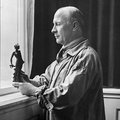 Bertram Mackennal
Bertram Mackennal
Works in the collection
- Share
-
-
About
Bertram Mackennal was among the first generation of artists born and trained in Australia to travel to Europe in the 1880s to further their studies. He arrived in London in 1882 and during the subsequent decade of his studentship, was broadly divided between Paris and London. Mackennal's practice was informed by his immersion in both the traditions and contemporary developments of sculpture in these centres, at a time when the influence of the Symbolist movement was keenly felt in current day practices. Mackennal also responded to the phenomena which became known in England as New Sculpture, a movement which incorporated a broad range of tendencies to revitalise the lifeless neoclassical model that had dominated sculpture practice throughout the century. While the lessons learnt by Mackennal from his association with the New Sculptors was varied, it was the Symbolist-inspired tendency to infuse the physical with suggestions of the spiritual that he sought as ideal in his early sculpture practice with which he established his international career.
Produced and exhibited at the Royal Academy in 1897, the statuette 'Daphne' is Mackennal's finest example of Art Nouveau sculpture. With its use of arabesque line and rhythmical emphasis driving the formation of its subjects, Art Nouveau had become a stylistic strategy of the European Symbolists to convey a sense of the spirit. Such elements were also adopted by New Sculptors as a means of suggesting animating forces beneath the flesh.
In his statuette Mackennal sought to depict the moment sourced from Classical mythology of Daphne's transformation into tree in order to escape Apollo's amorous pursuit. Yet Mackennal suggests a metamorphosis from the physical to the psychological realm. He composes the figure with Art Nouveau line, using this arabesque form to infer inner sensation and to fuse the figure with the metaphysical rhythms of nature. The artist constructs the metamorphosis of 'Daphne' as a liberation; an introspective embrace conveyed through the inward rhythms and the trance-like depiction of the subject. It was through the influence of Symbolism that Mackennal translated the figure of mythological narrative into an emblem of psychological drama.
The New Sculpture movement sought to foster new ways of experiencing modern sculpture seeing the rise in popularity of the statuette as a domestically and commercially scaled sculptural form in late 19th century practices. The New Sculptors displaced the traditional small scale antique copy with modern figures of imaginative contemplation. This program became the impetus for Mackennal's most evocative Academy sculptures, particularly 'Daphne', which is one of the artist's most unconventional compositions and compelling female figures. Mackennal had here followed British sculptor Alfred Gilbert's model in combining richly textured Art-Nouveau influenced organic forms with neo-Florentine statuette traditions in order to create a figure of self-involved intensity and covert eroticism that is one of the artist's most successful of this period.
-
Exhibition history
Shown in 10 exhibitions
Royal Academy of Arts, 1897, Royal Academy of Arts, London, 03 May 1897–02 Aug 1897
Early Australian sculpture, Art Gallery of Ballarat, Ballarat, 1976–15 Mar 1977
An exhibition of art nouveau in Australia, Art Gallery of Ballarat, Ballarat, 05 Feb 1981–04 Mar 1981
An exhibition of art nouveau in Australia, National Gallery of Victoria [St Kilda Road], Melbourne, 21 Mar 1981–20 Apr 1981
An exhibition of art nouveau in Australia, Queensland Art Gallery, South Brisbane, 19 May 1981–22 Jun 1981
An exhibition of art nouveau in Australia, S.H. Ervin Gallery, The Rocks, 17 Jul 1981–17 Aug 1981
Australian sculpture 1890-1919, Art Gallery of New South Wales, Sydney, 22 Jan 1987–22 Feb 1987
The great Australian art exhibition, Queensland Art Gallery, South Brisbane, 17 May 1988–17 Jul 1988
The great Australian art exhibition, Art Gallery of Western Australia, Perth, 13 Aug 1988–25 Sep 1988
The great Australian art exhibition, Art Gallery of New South Wales, Sydney, 21 Oct 1988–27 Nov 1988
The great Australian art exhibition, National Gallery of Victoria [St Kilda Road], Melbourne, 01 Mar 1989–30 Apr 1989
Sotheby's Australia: fine Australian paintings, Sotheby's Australia, Melbourne, 28 Apr 1997–29 Apr 1997
Bertram Mackennal, Art Gallery of New South Wales, Sydney, 17 Aug 2007–04 Nov 2007
Australian Symbolism, Art Gallery of New South Wales, Sydney, 04 May 2012–22 Jul 2012
Decorative arts: design from 1860, Lyon & Turnbull, Edinburgh, 13 Nov 2013–13 Nov 2013
Grand Courts collection rehang, Art Gallery of New South Wales, Sydney, Nov 2021–2023
-
Bibliography
Referenced in 18 publications
-
Jeremy Cooper, Nineteenth-century romantic bronzes: French, English, and American bronzes 1830-1915, Newton Abbot, 1975, 143 (colour illus.). not AGNSW version
-
Deborah Edwards, Australian sculpture 1890-1919, 'Australian sculpture 1890-1919'; 'Checklist', Sydney, 1987, n.pag.. not AGNSW version
-
Deborah Edwards, Bertram Mackennal: Catalogue raisonné, ''Adaptability and versatility': Bertram Mackennal - an overview', pg. 15-82, Sydney, 2007, 40, 41 (colour illus.), 47, 114, 172, 214. not AGNSW version
-
Noel Hutchinson, Early Australian sculpture, from its beginnings up to circa 1920, Ballarat, 1977, n.pag. (illus.). not AGNSW version; cat.no. 21
-
Lyon & Turnbull (Compilator), Decorative arts: design from 1860, 'British ceramics', pg. 42-111, Edinburgh, 2013, 69 (colour illus.). lot no. 278; estimated price £5,000-8,000
-
Denise Mimmocchi, Look, 'DAPHNE: Intense, erotic and now in our collection', pg. 16, Sydney, Oct 2014, 16 (colour illus.).
-
Denise Mimmocchi, Australian Symbolism: the art of dreams, ''The ideal somnambulist'', pg. 40-45, Sydney, 2012, 42 (illus.), 45, 146. not AGNSW version
-
Queensland Art Gallery, Queensland Art Gallery annual report 1990-91, 'Into space: the language of sculpture', pg. 16-17, Brisbane, 1990-1991, 17. not AGNSW version
-
Queensland Art Gallery, Selected works: Queensland Art Gallery, 'Australian art: colour plates', pg. 73-92, South Brisbane, 1982, 116 (illus.). not AGNSW version
-
Ron Radford, An exhibition of art nouveau in Australia, 'Art nouveau in Australia', pg. 10-17, Sydney, 1981, 11 (illus.), 34, 80. not AGNSW version; cat.no. 65
-
Royal Academy of Arts, The exhibition of the Royal Academy of Arts. The one hundred and twenty-ninth, London, 1897, 61. cat.no. 2039; not AGNSW edition
-
Royal Academy of Arts, Royal Academy pictures, 1897, 1897, 80 (illus.). not AGNSW edition
-
Lynne Seear and Julie Ewington (Editors), Brought to Light: Australian Art 1850–1965 from the Queensland Art Gallery collection, Brisbane, 1998, 62. not AGNSW version
-
Sotheby's Australia (Compilator), Sotheby's: Fine Australian and European Paintings, Drawings, Prints, Photographs and Sculpture, including the Hugh Jamieson collection of contemporary art, Melbourne, Apr 1997, (colour illus.). not AGNSW version; lot no. 241, estimated price $16,000-22,000
-
Daniel Thomas, Creating Australia: 200 years of art 1788-1988, 'Centenary art: the individual', pg. 126-131, Melbourne, 1988, 126, 127 (illus.), 246. not AGNSW version
-
Clare Williamson, The Australian antique collector, 'Australian art nouveau and symbolism', pg. 77-80, Sydney, Jul 1989-Dec 1989, 77 (illus.), 79. not AGNSW version
-
Athenaeum, 'The Royal Academy', pg. 73-74, London, 10 Jul 1897, 73. not AGNSW edition
-
Editor Unknown (Editor), South Australian Register, 'Australian artists. Success of painter and sculptor.', pg. 5, Adelaide, 07 May 1897, 5. not AGNSW edition
-




